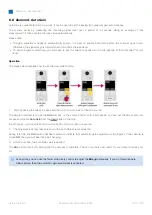
diamond - User Manual
Version: 8.0.0/1
Exported on: 24 October, 2023
117
/
228
•
•
•
•
•
•
•
•
M/S Decode
M/S is a stereo recording technique that uses two coincident microphones, one pointing to the
front (Middle) and the other (bi-directional) at right angles to provide the stereo ambience
(Side). The system provides M-S to X-Y decoding to turn a Middle and Side signal into normal
Left and Right stereo.
The incoming M/S signal should be connected to a stereo source:
Left Input - from the Middle (M) signal.
Right Input - from the Side (S) signal.
When the M/S stereo mode is active, the following calculations are applied:
Left channel = L+R (M+S)
Right channel = L-R (M-S)
By adjusting the
Pan
(Balance) control, you can vary the ratio of Middle to Side, and thereby adjust the width of the stereo
field.
Surround Panning
If surround panning is enabled for a source, then the pan parameters are extended as follows:
LCR Pan
-
left/
center/right pan position.
F/B Pan
- front/back pan position.
Slope
-
from
0.0 to 1.0.
LFE
- low-frequency effect (subwoofer) level, from -120 to +9 dB.
The
Slope
adjusts signals feeding the discrete center channel within the surround field. It may be used to balance between
discrete and phantom center signals. To see the effect, position the source at front center, and adjust the slope to a setting
of 1.0; the signal feeds only the discrete center output. Now set the slope to a value of 0.0; the signal feeds only left and
right (phantom center).
On a stereo source, you can adjust the left/right balance, front/rear pan and LFE level. Center slope is not available.
On a surround source, you can adjust LFE level only; the surround source is assigned directly to the surround bus (e.g. left
to left, center to center, etc.)
If a surround source is assigned to a stereo bus, then the source is mixed onto the bus according to the surround downmix
parameters set within the configuration. If a surround source is assigned to a mono bus, then the stereo downmix is
converted to mono by subtracting 3dB from, and then summing, the L and R channels.
















































